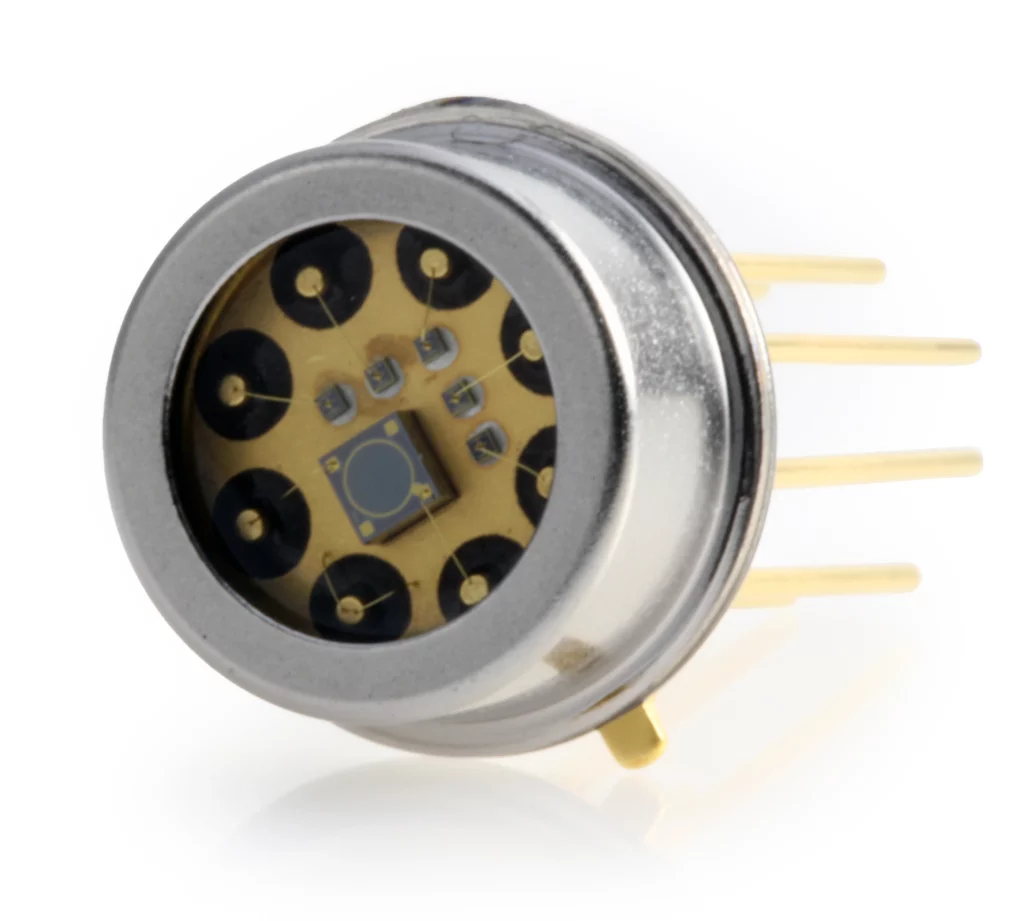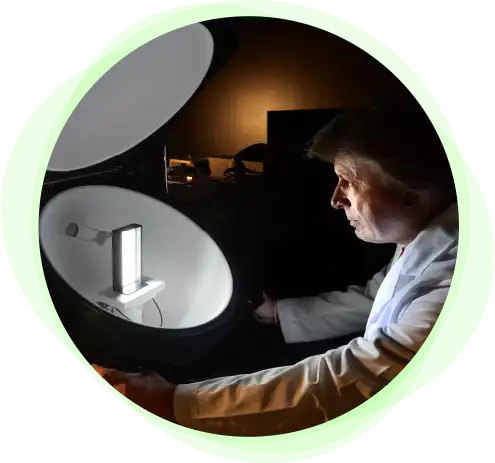Marktech Optoelectronics
3 Northway Lane North
Latham, NY 12110
Fax: +1-785-4725
Email: in**@ma**********.com
The broadest line of both silicon and InGaAs detectors commercially available.
Indium Gallium Arsenide (InGaAs) PIN photodiodes are made using InGaAs/InP technology.
Cutting-edge silicon photodetectors that excel in precise detection of light ranging in wavelength from 250nm to 1100nm
Monolithic “quads” or quadrant photodiodes (QPDs) are 2 X 2 photodiode arrays with four planar diffused photodiode elements or segments.
Marktech offers a broad line of silicon photo Transistors in a variety of package types ranging from miniature metal can to ceramic packages.
Our High-Reliability Photoreflectors are sensors that contain both the LED emitter and photodetector functions within a single package.
Marktech Si APD’s offer low-level light and short pulse detections of wavelengths between 400 nm and 1100 nm.
UV detectors are offered in a variety of TO metal-can type packages from TO-18 to TO-39 with special UV glass lens to insure optimum lifetime and the least amount of material degradation
With the ability to detect light in the UV, visible, and infrared spectrums, photo detectors, photo transistors, and photodiodes are being used in increasingly more applications.
Marktech offers the broadest range of emitters commercially available ranging from 235nm to 4300nm across the UV, visible, NIR, SWIR, and MWIR spectral ranges.
Marktech offers the broadest range of UV LEDs commercially available ranging from 235nm to 400nm including UVA, UVB, UVC, and deep UVC LEDs.
Our advanced line of visible LED products is engineered to deliver high-quality, energy-efficient lighting solutions across various applications from 400nm to 700nm..
Our NIR LED wavelength range is typically from 700nm to 1000nm, extending into wavelengths invisible to the human eye but crucial for numerous technological and scientific applications.
Our standard product offering includes wavelengths from 1020nm to 3000nm and operating currents ranging from 20mA to 350mA for high-power applications.
Our Point Source LEDs are specifically engineered for optical encoders, edge sensors, and other critical applications that demand highly focused light with minimal dispersion.
Multi-LED chips in a single package, our multiple wavelength LEDs are engineered to address a myriad of applications across the UV, visible, NIR, SWIR, and MWIR spectral ranges
Designed to produce a highly defined red dot or reticle, facilitating accurate aiming without revealing the location to the target.
Ideally suited for applications including edge sensing, line sensing, coin bill validation, and bar code reading
Our panels are crafted to deliver uniform, vibrant illumination across a wide range of applications, from consumer electronics to industrial displays.
Crafted with the latest LED technology, these rings provide adjustable illumination to meet specific needs, ensuring optimal visibility and enhancing the quality of your projects.
As a proud CREE LED Solution Provider for over a decade, Marktech offers comprehensive engineering support, including design, binning, and material selection, alongside custom packaging options for specialized applications.
CREE LED through-hole emitters, designed for high-temperature and moisture environments with UV-resistant optical-grade epoxy, offer a range of colors for versatile applications in signage and lighting.
CREE High Brightness (HB) SMD LEDs are the brightest, most reliable architectural, video, signage, scoreboard, roadway, and specialty LEDs available today.
CREE LED’s P4 series represents a leap in LED design, combining efficiency with aesthetic versatility to meet the demands of modern lighting applications.
Marktech’s CREE LED XLamp® offerings on aluminum core starboards simplify LED integration for designers, providing a range of colors and angles on compact boards for easy testing and implementation in varied lighting applications.
Marktech Optoelectronics introduces its new product line of CREE LED die, including the EZ1350 Series Die, packaged in TO-cans (TO-18 and TO-39 outlines) designed for precision and reliability in demanding applications with protection against environmental factors like moisture and dust.
Marktech Optoelectronics combines over 40 years of expertise in optoelectronics with a focus on customized engineering solutions, addressing specific customer needs and applications.
Custom photodiode detectors are designed to meet unique customer requirements, offering specialized performance features and cost savings through optimizations such as integrated filters, photodiode arrays, and hybridization.
Through our vertically integrated manufacturing facilities in California and Japan, we offer custom LED solutions, including packaging and optoelectrical categorization, enhancing product design and market readiness.
Multiple LED dies combined in a single package are engineered to address various applications across the UV, visible, NIR, SWIR, and MWIR spectral ranges.
To succeed, you need the exact optoelectronic package custom-designed and manufactured for your application, including hermetic metal SMD, TO-can, plastic SMD, and molded through-hole packaging.
Made-to-order semiconductor chips (die) and wafers are designed and fabricated to fit your needs. Standard dies are available in specific wavelengths for high-volume production applications.
Bare and encapsulated LEDs, photodiodes, and other components are assembled on FR4, metal-cored, and flexible circuit boards, ready for production.
Learn about the latest trends, devices, and potential applications.
The latest news and announcements from Marktech Optoelectronics.
Detailed information about common uses for Marktech Optoelectronics devices.
In depth discussions on LEDs, Detectors and the science behind them.
Become familiar with common terminology and concepts for LED Devices.
List of common concepts and definitions for Photodiodes.
Marktech Optoelectronics quad photodiodes have low dark current, high resolution or precision, high accuracy, high response with low noise (high S/N ratio), wide spectral ranges, good frequency bandwidth, excellent dynamic range, minimal element spacing, low operating voltages, high shunt resistance, and large active areas. Marktech also manufactures both silicon and InGaAs linear arrays, which are used in dispersive spectroscopy and triangulation position sensing.

| Product | Photo | Segments | Peak Wavelength | Size | Active Area | Spectral Range | Specs | Buy Now |
|---|---|---|---|---|---|---|---|---|
| MTPD4346T38-300 |

|
4, 2x2 | 1600 | TO-5 Metal Can Flat Lens (8 pin) | 3.0 mm | 600-1750 |
|
Price Quote |
| MTSM2601SMF2-SP4-030 |
.jpg)
|
4, 2x2 | 1850 | 5.0x5.0 mm SMD Flat Lens | 3.0 mm | 800-2600 |
|
Price Quote |
| MT03-004 |

|
4, 2x2 | 940 | TO-5 Metal Can Flat Lens (4 pin) | 5.8 mm | 400-1100 |
|
Digikey |
| MT03-072 |
.jpg)
|
4, 2x2 | 940 | TO-8 Metal Can Flat Lens (6 pin) | 50 mm2 | 350-1100 |
|
Digikey Mouser |
| MT03-081 |
.jpg)
|
4, 2x2 | 950 | 7.24x7.24 mm SMD Flat Lens | 5.8 mm | 350-1100 |
|
Price Quote |
Two segment, dual element, or bi-cell photodiodes are another type of position sensing device commonly incorporated into alignment or positioning systems. While quadrant photodiodes can sense position along two dimensions or both the X & Y axes, bi-element photodiodes align or position along one dimension or axis.
Marktech’s four-element photodiode arrays or quad detectors provide flawless performance in laser alignment and nanopositioning applications. Quadrant photodiodes (QPDs) or quadrant position sensitive detectors typically have resolutions as low as 10nm using beams with optical powers from 10 to 100microWatts. Quads can be used in auto-collimators for laser alignment, optical trackers, atomic force microscopes, scanning probe microscopes, stage positioners, surface profilometers, mask aligners, beam centering systems, fine sun sensors, ellipsometers, optical tweezers, tilt sensors, high accuracy displacement sensors, and other ultra-precision positioning applications. The fast response and wide operational bandwidth of QPDs have made these positioning devices dominant in the atomic force microscope (AFM) industry (Chien, et al.). Satellite communication systems can benefit from quadrant photodiodes as well. For example, quadrant photodiodes are key components in quadrant photoreceivers (QPRs) front-end devices for inter-satellite laser interferometry.
Both bi-cell and quadrant photodiodes are photodiode arrays (PDAs), with two (1X2) and four (2X2) elements, respectively. Bi and quad PDs are suitable for alignment or position sensing over a small beam displacement or position range. For laser or light beam position sensing over a larger range, longer, multi-element photodiode arrays are necessary.
Marktech Optoelectronics also manufactures multi-element linear (one dimensional, 1D) and area (two dimensional, 2D) photodiode arrays with many segments for dispersive spectroscopy, refractometry, distance or range finding (triangulation position sensing), interferometry, and particle analyzers. Most photodiode arrays applications require custom-designed arrays and OEM integration, which is one of Marktech’s industry leading capabilities. Marktech’s detector experts have designed and manufactured photodiode arrays with 2, 4, 16, 20, 32, 64, and more elements.
Our InGaAs quadrant photodiodes and photodiode arrays have a wavelength sensitivity range from 600nm – 2600nm. Our silicon quadrant photodiodes and photodiode arrays have a wavelength sensitivity range from 250nm – 1100nm. These die can be packaged individually in a variety of hermetically sealed TO packages or integrated into a custom package (PLCC, COB, ATLAS hermetic SMD, ceramic carrier, etc.) to suit your specific application and pin-out design specs.
In scientific laboratories and research institutions, quadrant and linear photodetector arrays play a crucial role in measuring light intensity and wavelength. They are extensively used in fields such as spectroscopy and precision distance or position measurement to facilitate accurate data collection, enabling breakthroughs in physics, chemistry, biology, and more.
Quadrant photodetectors are commonly employed as “quadrant optical receivers in free space communications. The quadrant enables both tracking and data transmission between between satellites and between a satellite and earth stations.
In the medical and biotechnology industries, silicon and InGaAs linear photodetector arrays are invaluable in diagnostic assays leveraging spectrometry methods.
Quadrant photodiodes are a key guidance element in missile systems. Quadrant mounted on the tip of a missile can track a spottiing laser beam on a target. Quadrant photodetectors are also extensively utilized in aerospace and defense laser based communications systems.
From monitoring air quality to studying climate change, silicon and InGaAs photodiode arrays enable precise measurement of light spectrums and particulate levels. IR spectroscopy relies on InGaAs arrays for gas sensing.
Silicon and InGaAs quadrant and linear photodiode arrays are a key part of many photoelectric sensors, optical encoders, and range finders, which can precisely measure position, distances, angular position, and presence of objects. These end products are critical in the industrial automation, defense, and automotive fields.
The specific optical and electrical characteristics of our quadrant and linear photodiode arrays depend on the photodiode material used in construction. Marktech can provide monolithic and assembled quadrants and arrays in silicon and 1.7μm InGaAs.. For the 2.6μm InGaAs material, we only provide assembled quadrants and linear arrays, which can be more cost effective than monolithic version for applications with small annual requirements.
Do you need a small number of LEDs for your proof of concept? Or, are you looking to purchase a run for your prototypes? Visit our online stores at Digi-Key Electronics and Mouser Electronics today. In Japan, our products are now available through Rikei Corporation. In Israel, our products are now available through Militram. In Canada, our products are now available through ARL Group.

Let us help select the perfect parts and services to make your application come to life.


As our industry constantly changes and evolves, Marktech has been there since the start. Stay on top of new and upcoming technology trends, industry news and new product offerings.
Marktech Optoelectronics
3 Northway Lane North
Latham, NY 12110
Fax: +1-785-4725
Email: in**@ma**********.com